Gregory A. Fournier's Blog, page 33
March 20, 2015
Gaslighting--A Sociopath's Favorite Tool
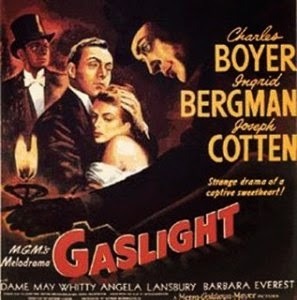 The psychological phenomenon know as gaslighting has become a colloquial term to describe a form of mental abuse where a dominant individual manipulates a weaker person's sense of psychological well-being to undermine the victim's mental stability. It is the manipulation of external reality to make someone doubt their sanity.
The psychological phenomenon know as gaslighting has become a colloquial term to describe a form of mental abuse where a dominant individual manipulates a weaker person's sense of psychological well-being to undermine the victim's mental stability. It is the manipulation of external reality to make someone doubt their sanity.The term derives from the popular 1944 American film entitled Gaslight--based on a 1938 British stage play. Frenchman Charles Boyer plays the sociopathic husband of the psychologically frail Ingrid Bergman. This memorable film portrays a husband's attempt to destroy his wife's sanity by manipulating her perception of reality, so he can steal her jewels.
 Charles Boyer and Ingrid BergmanSociopaths instill a high level of anxiety and confusion to disorient their victims. Information is twisted and spun by them so victims begin to doubt themselves. Targets lose faith in their ability to make judgments and become insecure about their decision-making abilities.
Charles Boyer and Ingrid BergmanSociopaths instill a high level of anxiety and confusion to disorient their victims. Information is twisted and spun by them so victims begin to doubt themselves. Targets lose faith in their ability to make judgments and become insecure about their decision-making abilities. Gaslighting describes an antisocial personality disorder that relies on deception, denial, mind games, sabotage, isolation, and destabilization. It is a form of narcissistic abuse that occurs in all types of relationships and every walk of life. This syndrome is often associated with marital relationships, but anyone can be a victim. Gaslighting can be seen in abusive parent-child relationships and in the workplace with an aggressive boss brow-beating his employees. It is mental bullying that can escalate into physical violence. These narcissists are puppet masters who often manipulate people for their own personal gain or to play twisted power and control games.
Gaslighting is a deliberate and progressive method of covert control that imposes a form of psychosis on its victims. Brainwashing, interrogation, isolation, and torture are all forms of psychological warfare used by the military, intelligence agencies, law enforcement, and terrorist organizations. On any level, it is a human and civil rights violation.

***
For more detailed information on gaslighting and a link to The National Domestic Violence Hotline, view the following link: http://www.thehotline.org/2014/05/what-is-gaslighting/
Published on March 20, 2015 04:42
March 5, 2015
Linking the Rainy Day Murders--One University of Michigan Psychiatrist's View

While I was reorganizing and packing my files, I came across an interesting article that won't make it into my non-fiction account--The Rainy Day Murders--about the Washtenaw County, Michigan murders of the late sixties. I thought I would share it with my readers.
***
After the murder of University of Michigan graduate student Alice Elizabeth Kalom on June 8th, 1969--the sixth of the series--Associate Professor of Psychiatry Dr. Donald Holmes gave his theory on the possible mental quirks and personality of the killer.
The Detroit News reported the U of M professor's belief that "These murders have too much in common not to be linked. All of the unsolved murders were committed by the same man. The killer is a smooth operator who digs chicks. He is undoubtedly of high intelligence and supremely self-centered and a successful attention getter."
After John Norman Collins had been arrested for the first degree murder of Karen Sue Beineman six-weeks later, The Detroit News asked Dr. Holmes for a second hypothetical evaluation in the light of recent developments.
"As far as the murders being linked. I think they may be. I don't think it's a coincidence. They have too much in common. It may be one man or a couple (people) acting together--like Leopold and Loeb, for example, only better organized."
When the professor was asked about the stepped-up tempo of the slayings that spring and summer, he explained that "the slayer could be terrified the first time by his own act, but later the barriers were broken between reality and fantasy. He could do it more easily again."
***
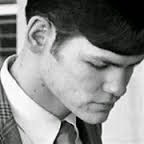 People often ask me if John Norman Collins worked alone. There is no hard evidence to prove that he had help killing his victims, but other people knew about the first and the second murders. The same can be said for the fifth, sixth, and seventh murders.
People often ask me if John Norman Collins worked alone. There is no hard evidence to prove that he had help killing his victims, but other people knew about the first and the second murders. The same can be said for the fifth, sixth, and seventh murders.By my count, at least three other people were privy to information that could have spared some of the victims' families and friends untold suffering--people who may not have been directly involved with the slayings but who had knowledge and were Collins' close associates. Of that, I am certain!
Published on March 05, 2015 06:22
February 26, 2015
Some Serial Killers Seek Recognition But Not All
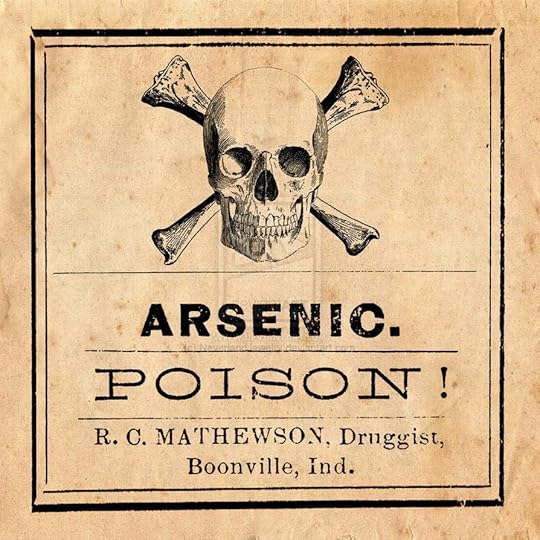 In his classic work, The History of Murder, Colin Wilson gives three reasons for murder. The first is for economic gain. It could be a robbery or kidnapping incident that goes terribly wrong, or it could involve an insurance or inheritance scheme. Poisoning was popular in the nineteenth century before it became easily detected in the bloodstream in the early age of forensic chemistry. Poisoning was so common during the Victorian period that police dubbed arsenic “inheritance powder.”
In his classic work, The History of Murder, Colin Wilson gives three reasons for murder. The first is for economic gain. It could be a robbery or kidnapping incident that goes terribly wrong, or it could involve an insurance or inheritance scheme. Poisoning was popular in the nineteenth century before it became easily detected in the bloodstream in the early age of forensic chemistry. Poisoning was so common during the Victorian period that police dubbed arsenic “inheritance powder.” "No one attacks me with impunity."A second type of murder is the resentment murder over a real or perceived slight. Somebody harbors a deep rage against society, government, religion, or even a person for some personal affront. Revenge murders fall under this category. The famous Edgar Allen Poe revenge tale “The Cask of Amontillado” begins with these all too human words, “The thousand injuries of Fortunato, I bore as best I could. But when he ventured upon insult, I vowed revenge.” What the insult was is never made clear. It is irrelevant because the killer--Montresor--admits to the cold-blooded murder fifty years later as he casually boasts of his cunning. He couldn’t die without first telling someone of his crime.
"No one attacks me with impunity."A second type of murder is the resentment murder over a real or perceived slight. Somebody harbors a deep rage against society, government, religion, or even a person for some personal affront. Revenge murders fall under this category. The famous Edgar Allen Poe revenge tale “The Cask of Amontillado” begins with these all too human words, “The thousand injuries of Fortunato, I bore as best I could. But when he ventured upon insult, I vowed revenge.” What the insult was is never made clear. It is irrelevant because the killer--Montresor--admits to the cold-blooded murder fifty years later as he casually boasts of his cunning. He couldn’t die without first telling someone of his crime. 
The last major reason author Colin Wilson gives for people killing one another is sexual. A sexual predator may want to prevent later identification by a rape victim, may have a psychotic hatred of the opposite sex, or may have a psychological compulsion to rid the world of harlotry or some other perceived moral evil.
Sexual homicide falls in the FBI category of unexplained murder. This type of murder is most troubling for law enforcement because of its apparent random nature. When a series of unsolved murders occurs within a well-defined area, feelings of vulnerability, panic, and fear can grip a whole community. Intense press coverage often does little more than advertise the problem to the public and complicate the situation for police. Serial killers like to act out their cat-and-mouse games with the police and manipulate the public through the media coverage their crimes generate.
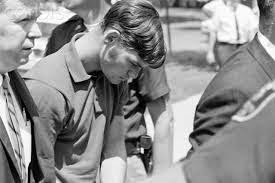 John Norman Collins' perp walkAfter the fourth unsolved murder in Washtenaw County, Michigan in the late 1960s, the college town of Ypsilanti went into lock-down mode. Yet, three more young women would die before John Norman Collins was arrested on July 31, 1969, for the sex-slaying of Karen Sue Beineman. The wave of mutilation murders—over the two year period—finally ended.
John Norman Collins' perp walkAfter the fourth unsolved murder in Washtenaw County, Michigan in the late 1960s, the college town of Ypsilanti went into lock-down mode. Yet, three more young women would die before John Norman Collins was arrested on July 31, 1969, for the sex-slaying of Karen Sue Beineman. The wave of mutilation murders—over the two year period—finally ended.***
Psychologist Dr. Stephen Giannangelo believes that serial killers have a “lost sense of self and intimacy, inadequacy of identity, and feelings of no control.” It is thought that these killers’ minds create a mirrored reality where satisfying their sexual needs and sadistic thoughts is the only palpable reality. Stalking and the ensuing capture indicate that these killings are often premeditated and rehearsed events. What makes serial killers different than most other killers is they tend to be more intelligent and learn from their mistakes.
 Dennis Rader in courtMany serial killers are perversely proud of their work as evidenced by their tendency to brag after they are caught. Dennis Rader of Kansas, Missouri was even bolder. Dubbed the “BTK” (Bind, Torture, and Kill) killer by the Wichita press, Rader began to brag in the form of a complaint letter to local news station--KAKE-TV. “How many people do I have to kill before I get my name in the paper or some national attention?” he asked.
Dennis Rader in courtMany serial killers are perversely proud of their work as evidenced by their tendency to brag after they are caught. Dennis Rader of Kansas, Missouri was even bolder. Dubbed the “BTK” (Bind, Torture, and Kill) killer by the Wichita press, Rader began to brag in the form of a complaint letter to local news station--KAKE-TV. “How many people do I have to kill before I get my name in the paper or some national attention?” he asked. Dennis Rader admitted to seven murders and said he was planning an eighth. He felt invisible and wanted to be noticed. He wasn’t content to torture and control a mere human being. He wanted to terrorize and manipulate a whole city. Such was his twisted ego. He was subsequently identified and captured. He boasted that he considered himself among the elite of serial killers--every bit the equal of H.H. Holmes, Jack the Ripper, and Ted Bundy.
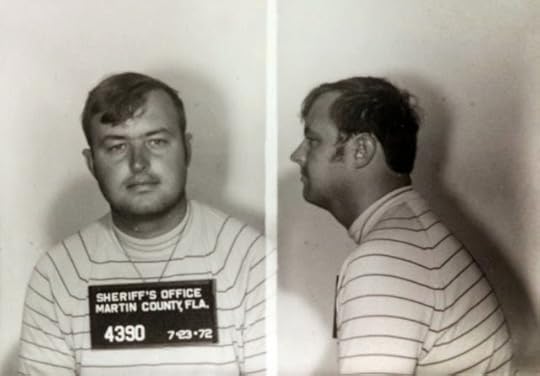 Gerald Schaefer mug shotsAnother serial killer proud of his work was Gerald John Schaefer. After being found unfit to be a school teacher, he was also rejected for the priesthood. Schaefer eventually became a deputy sheriff in Florida where he was able to hide behind the mask of a police officer. After his trial and conviction for the murder of two young women, he was so boastful and obnoxious in prison that one December night in 1995, Gerald John Schaefer had a fatal reaction to some sharpened steel--an early Christmas present from his cellmate. Serial killers often do not fare well behind bars.
Gerald Schaefer mug shotsAnother serial killer proud of his work was Gerald John Schaefer. After being found unfit to be a school teacher, he was also rejected for the priesthood. Schaefer eventually became a deputy sheriff in Florida where he was able to hide behind the mask of a police officer. After his trial and conviction for the murder of two young women, he was so boastful and obnoxious in prison that one December night in 1995, Gerald John Schaefer had a fatal reaction to some sharpened steel--an early Christmas present from his cellmate. Serial killers often do not fare well behind bars. Despite some serial killers having above average intelligence, they become bold, compulsive, and arrogant. These are often narcissistic individuals who consider themselves gifted and smarter than everyone else--especially law enforcement. Each time serial killers get away with their crimes, they become more confident until they start making mistakes. Crime studies indicate that most serial killers willingly talk about their crimes once they are caught red-handed or when the police have irrefutable evidence against them.
One notable exception to this serial killer characteristic is John Norman Collins. He has never admitted culpability for any of his crimes or shown the slightest bit of remorse. Collins has maintained his innocence for decades--despite overwhelming evidence against him.
Published on February 26, 2015 05:26
February 19, 2015
Detroit's Stroh's Brewing Company--With Its Days of Future Passed
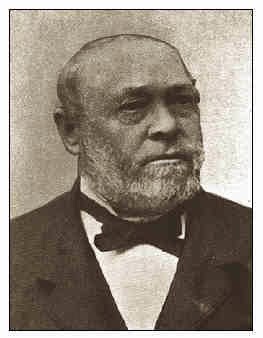 Founder Bernhard StrohAvoiding the German Revolution of 1848, Bernhard Stroh emigrated to the United States with knowledge of the brewing trade from his father Georg Friedrich Stroh--landowner and inn keeper. He was taught the Pilzen method of brewing a light-lager beer. In 1850--at the age of twenty-eight--Stroh established his basement brewery operation in Detroit with a $150 investment. Immediately, he started brewing Bohemian-style lager beer in copper-clad kettles that promoted the carmelization of the wort--unfermented beer--that made the beer lighter without reducing the flavor.
Founder Bernhard StrohAvoiding the German Revolution of 1848, Bernhard Stroh emigrated to the United States with knowledge of the brewing trade from his father Georg Friedrich Stroh--landowner and inn keeper. He was taught the Pilzen method of brewing a light-lager beer. In 1850--at the age of twenty-eight--Stroh established his basement brewery operation in Detroit with a $150 investment. Immediately, he started brewing Bohemian-style lager beer in copper-clad kettles that promoted the carmelization of the wort--unfermented beer--that made the beer lighter without reducing the flavor.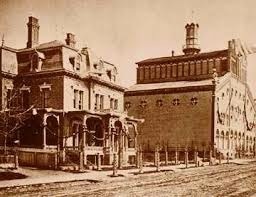 Stroh's home and first brewery buildingStroh's beer was sold door-to-door in beer buckets from a wheelbarrow, but soon horse-drawn wagons would be delivering his authentic German beer across town in barrels. Bernhard Stroh expanded his business in 1865 and adopted the heraldic lion emblem from the Kyrburg Castle in Germany. The lion icon is still visible in Stroh's product labeling.
Stroh's home and first brewery buildingStroh's beer was sold door-to-door in beer buckets from a wheelbarrow, but soon horse-drawn wagons would be delivering his authentic German beer across town in barrels. Bernhard Stroh expanded his business in 1865 and adopted the heraldic lion emblem from the Kyrburg Castle in Germany. The lion icon is still visible in Stroh's product labeling.Oldest son Bernhard Stroh Jr. assumed leadership of the brewing business when his father died on June 28, 1882 at the age of 59. The company patriarch was buried at Elmwood Cemetery in Detroit, Michigan. Bernhard Jr. introduced pasteurization and refrigerated rail cars which increased the shelf-life of their product and broadened their markets. Stroh's became the Detroit area's signature beer.

In 1908, Julius Stroh took over the family business from his brother. After a celebrated tour of Europe's finest breweries, Julius introduced direct flame--rather than stream--to heat the copper kettles. The company motto became "America's Only Fire-Brewed Beer" and part of the brand's labeling.
Prohibition was tough on the beer brewing industry and many breweries closed across the country. Rather than shut down and abandon their loyal workers, the company diversified and made near-beer (non-alcoholic), soft drinks, and ice cream. It is not unlikely that Stroh's Brewery may have made specially-ordered batches of the Real McCoy for Detroit's vast Speakeasy network. The country may have been dry, but Detroit was awash in booze. After Prohibition, the business grew and Stroh's became a regional favorite.
 What Detroiters recognize as Stroh's.A statewide strike halted beer production in 1958 which gave national brands a foothold in the Michigan beer market. In the 1960s, the Stroh family wanted to move the company into the national arena. They bought the Goebel Brewing Company--their rival across the street--in 1964. This increased Stroh's brewing capacity and solved the company's short term growing pains. Some twenty years later, Stroh's was sold in seventeen states. They needed even more brewing capacity, so they bought Schaefer Brewing Company--that had recently gone belly-up in the Miller beer advertising wars.
What Detroiters recognize as Stroh's.A statewide strike halted beer production in 1958 which gave national brands a foothold in the Michigan beer market. In the 1960s, the Stroh family wanted to move the company into the national arena. They bought the Goebel Brewing Company--their rival across the street--in 1964. This increased Stroh's brewing capacity and solved the company's short term growing pains. Some twenty years later, Stroh's was sold in seventeen states. They needed even more brewing capacity, so they bought Schaefer Brewing Company--that had recently gone belly-up in the Miller beer advertising wars.Then in 1982, Stroh's bought the Schlitz Brewing Company to become America's third-largest brewer--producing many well-known brands like Goebel, Schaefer, Schlitz, Old Milwaukee, Colt 45, and many others. In 1985, the 135-year-old-brewery on the East Side was simply outdated and had no room to expand. The following year it was imploded--a better fate than many of Detroit's factory ruins.
The Stroh's company business plan was to buy up struggling breweries and drive up the company's market share. Stroh's $500 million heavy debt load to buy Schlitz weakened the company's financial position and left them cash poor to compete with the onslaught of Anheuser-Busch and Miller Brewing Company's national marketing campaigns.
In 1990, Coors moved past Stroh's as America's #3 brewer. Stroh's market share dropped 50%. Beer analysts felt that Stroh's came to the light-beer party late. In 1973, Miller Brewing created Miller Lite beer and used macho football players and "tough guys" like pulp-fiction author Mickey Spillane. Miller's "Tastes Great/Less Filling" debate was a stroke of marketing genius. The Budweiser Clydesdales were a potent marketing image for Stroh's to compete with as well.

From the beginning of the company, Stroh's catered to working-class tastes at working-class prices. But Joe Six-Pack had moved on. Beer marketing shifted away from the product and onto the drinker. Advertising slogans like "This Bud's for You" and "It's Miller time--You earned it!" had great appeal to blue-collar beer drinkers. Coors' Silver Bullet promotion was the last straw.
In 1999--unable to compete in the twenty-first century--the 149 year-old brewer closed, and its assets were broken up and sold for the sum of their parts to Pabst Brewing and Miller Brewing companies. Many of the Stroh's brands were discontinued or sold off to other companies. Pabst acquired the well-known brands Colt 45, Schlitz, and Old Milwaukee--Miller got Mickey's Malt Liquor and the Henry Weinhard's line of beers.
 Today's Stroh's is produced by Miller Brewing Company. They don't use the special open-flame copper kettles, and the taste reflects the difference. The traditional Stroh's label read "America's Only Fire-Brewed Beer," but now it reads "America's Premium Brewed Beer."
Today's Stroh's is produced by Miller Brewing Company. They don't use the special open-flame copper kettles, and the taste reflects the difference. The traditional Stroh's label read "America's Only Fire-Brewed Beer," but now it reads "America's Premium Brewed Beer."As for the Stroh's family legacy, somehow the seventh generation has managed to lose over $700 million. Forbes magazine reports that by 2008, the family fortune was completely tapped out.
Published on February 19, 2015 06:55
February 12, 2015
How FBI Serial Killer Profiling Works
 Because of the growing number of requests for profiling services in the 1980s, the FBI's Behavioral Science Unit made their services available to law enforcement nationwide through their Violent Criminal Apprehension Program (VICAP)--which maintains a nationwide network of computer databases dedicated to taking violent offenders off the streets as quickly as possible.
Because of the growing number of requests for profiling services in the 1980s, the FBI's Behavioral Science Unit made their services available to law enforcement nationwide through their Violent Criminal Apprehension Program (VICAP)--which maintains a nationwide network of computer databases dedicated to taking violent offenders off the streets as quickly as possible.The VICAP Crime Analysis Report runs for ten pages of detailed law enforcement reporting for each murder. Factors such as age, gender, occupation, intelligence, acquaintance with the victim, residence, mode of transportation, modus operandi, ritualistic behavior, victim characteristics, and offender characteristics are recorded and entered into their database.
When two or more murders have been committed over time by the same person(s), a dynamic synergistic comparison can give investigators a systematic look at the presence or absence of evidence, the crime scene signature, the comfort zone of the killer, and the possible motives for the murders. Other indicators such as emotional intensity, the rationale for the murders and any number of factors that stand out to investigators can help law enforcement identify offenders. Criminal profiling gives investigative agencies the ability to connect details, recognize patters of offender behavior, and review national fingerprint and DNA databases which facilates the work of narrowing down suspects.

The intent of crime scene investigation and psychological profiling is to identify the key elements of the scene and the behavioral factors related to serial killers--enabling homicide investigators to prioritize leads and apprehend offenders before they can kill again. A developing composite profile does not provide the identity of the offender but merely indicates the type of person most likely to commit such a crime having these characteristics. One researcher, Geberth (1981), found that a murderer’s behavior and personality is reflected in the crime scene “much the same way as furnishings reveal the homeowner’s character.” Sexual homicide crime scenes reveal information about the killer’s behavior and how he furnishes his mind.
When crime scene characteristics are combined with profile characteristics, a composite picture of the behavioral traits of the offender begins to take shape. With serial killers, the profile comes into sharper focus with each new victim. From these elements, investigators are able to draw assumptions about the killer, but they need to be always on guard against tunnel vision—making conclusions that place limitations upon the investigation.
***
The FBI’s Behavorial Science Unit (BSU) researchers found that serial killers suffer from antisocial personality disorder, a pervasive pattern of disregard for the rights of others. They have no conscience and usually show a history of petty crime. Serial killers make the leap from sociopaths to psychopaths when the predatory urge overwhelms them.
The BSU study discovered that most serial killers share many of the same formative experiences growing up:
They had a history of being bullied or socially isolated as children and adolescents. They often engaged in petty crimes like theft, fraud, or vandalism. They are practiced liars. Many come from unstable families and have experienced a serious family disruption like divorce, separation, or a breach in the parent/child relationship. Many have a history of being abused emotionally, physically, and/or sexually in their youth by a family member. They often manifest attachment disorder due to early childhood trauma like violence, neglect, rejection, or pervasive alcohol or drug use in the home. They suffer from low self-esteem and retreat into a fantasy world where they are safe and in control. They are fascinated by fires and fire starting. And they often show cruelty to younger children and/or small animals.
Additional common traits of serial killers documented by the BSU were:
A serial killer’s motivation is usually psychological gratification of some sort. They have a compulsive need for power and control over their victims. They suffer from mental illness with psychotic episodes and have mental illness or alcoholism in their family backgrounds. They have a passion for throttling which leads to overkill. They often display a blood lust by mutilating, dismembering, or disemboweling their victims. They have an overwhelming desire to inflict pain and terror, and many violate the bodies of victims with foreign objects. They are predators of victims weaker than themselves: children and defenseless women in particular. They lack remorse or guilt and project blame upon their victims. They suffer from impulsivity and are oversexed with intense sexual frustration. They have fits of self-pity and resentment. They often begin their crimes with peeping in windows and home burglary--which often escalates to rape and murder. They are compulsive liars and petty thieves. They usually stalk their victims but will take advantage of crimes of opportunity.They often take trophies from the crime scenes, photos, or body parts as souvenirs to relive their orgies of depravity. They often wear a mask of sanity in public for protective coloration. Their boundaries between fantasy and reality are lost. Their fantasies turn to dominance, control, sexual conquest, violence, and finally murder. Not every serial killer fits each one these traits, but it is striking how consistently many of these traits appear in the profiles of every known serial killer.
 These common characteristics help investigators form a composite picture of an offender. Drawing conclusions about a suspect from profile characteristics is as much art as science, and it takes a trained eye and a bit of luck to pay dividends, but when done properly, the likelihood of catching a serial killer is greatly enhanced.
These common characteristics help investigators form a composite picture of an offender. Drawing conclusions about a suspect from profile characteristics is as much art as science, and it takes a trained eye and a bit of luck to pay dividends, but when done properly, the likelihood of catching a serial killer is greatly enhanced.
Published on February 12, 2015 06:21
February 5, 2015
Toxic Behaviors--Recognizing Sociopaths
 One in twenty-five people is a sociopath. These are people with an instinctual ability to exploit weakness and vulnerability. Sociopaths read and study their victims--this is their great advantage over us. They know us better than we know them. Their propensity to exploit weakness is their hidden skill. Once they target their prey, their victims are compromised. People who can see through a sociopath’s deceptions are avoided or eliminated. Discovery is the last thing they want.
One in twenty-five people is a sociopath. These are people with an instinctual ability to exploit weakness and vulnerability. Sociopaths read and study their victims--this is their great advantage over us. They know us better than we know them. Their propensity to exploit weakness is their hidden skill. Once they target their prey, their victims are compromised. People who can see through a sociopath’s deceptions are avoided or eliminated. Discovery is the last thing they want. But this speaks to them. What about us? Why do so many of us seem vulnerable to sociopaths? One answer may be that many of us have a mild to moderate affinity for danger and a hunger for excitement to punctuate our otherwise mundane lives. Many people enjoy controlled risks and love cheap thrills they can get an emotional rush from and then return to the safety of our homes. Vicarious experiences from action and thriller fantasies on the silver screen, to riding the latest and greatest amusement park rides, fill this void for most of us.
 Leonardo Dicaprio in The Great Gatsby.
Leonardo Dicaprio in The Great Gatsby. American pop culture presents a high-octane lifestyle of the rich and famous, often fueled by drugs, alcohol, and conspicuous wealth that create an unrealistic expectation for success that most Americans can never hope to achieve. We idolize famous actors, successful athletes, dubious celebrities, and people with money. We long for our own sense of celebrity--anything to quell the routine boredom of our conventional lives. We hunger for excitement, so most of us are willing to take the occasional risk and let down our guard.
Part of our American folklore informs us that dangerous people are charismatic. Going for the bad boy seems like a coming-of-age ritual for many young women in our culture--the proverbial moth attracted to the flame. How many intelligent women get over their heads in relationships with men who aren’t as smart because they perceive the man to be exciting, sexy, or notorious? The answer is simply too many. These relationships often become controlling, degrading, and violent. Sometimes, they become fatal.
Everyday life is routine and tedious much of the time, and we are creatures of habit. So every once in a while, many of us like to step out of our hum-drum lives and relax our defenses. Predators know this. When someone or something doesn’t seem right, people should go with their instincts and not ignore the warning signs.
Here are ten traits of sociopaths to watch for:
1. Sociopaths don’t have a conscience.
2. They suffer from attachment disorder.
3. They are easily bored and need continual stimulation.
4. They are not comfortable in their own skin.
5. They are absolutely self-involved and high-strung.
6. They tend toward hypochondria and seek pity to manipulate others.
7. They are not team players.
8. They show unremitting self-interest.
9. They use and abuse people with impunity.
10. They are narcissists who know the words but not the music of life.
 (Source unknown.)
(Source unknown.)Sociopaths make full use of social and professional roles which provide a ready-made mask. Many of us are irrationally influenced by people in positions of authority or in uniform. Conventional wisdom insists that You can’t judge a book by its cover, but people do so routinely. We have all heard and seen news reports of police, teachers, clergymen, and childcare providers who abuse the trust placed in them. Their roles or the masks they wear constitute their protective coloration or camouflage.
Serial killer Gerald John Schaefer became a teacher after college but was fired for “totally inappropriate behavior” by the school’s headmaster. Next, he tried to get into the priesthood and was quickly rejected. Then, he became a policeman. Each of these authoritarian roles would have placed Schaefer in a position of power to exploit and abuse people.
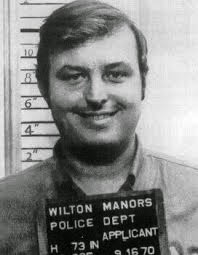 As a patrolman, Schaefer picked up two teenage girls who were hitchhiking on July 21, 1972--one seventeen and the other eighteen. He took them to a secluded place in a remote wood, tied them to a tree, and threatened to kill them or sell them into prostitution if they tried to escape. He had to answer a police call on his radio and left. When he returned, the girls had escaped and made their way to the local police station, the same station where Patrolman Schaefer worked. He was arrested and posted bail. Two months after his release, he pulled the same stunt. He abducted Susan Place--age seventeen--and Georgia Jessup--age sixteen. Schaefer tortured, murdered, and buried them on Hutchinson Island, Florida.
As a patrolman, Schaefer picked up two teenage girls who were hitchhiking on July 21, 1972--one seventeen and the other eighteen. He took them to a secluded place in a remote wood, tied them to a tree, and threatened to kill them or sell them into prostitution if they tried to escape. He had to answer a police call on his radio and left. When he returned, the girls had escaped and made their way to the local police station, the same station where Patrolman Schaefer worked. He was arrested and posted bail. Two months after his release, he pulled the same stunt. He abducted Susan Place--age seventeen--and Georgia Jessup--age sixteen. Schaefer tortured, murdered, and buried them on Hutchinson Island, Florida. Most people readily accept the superficial trappings of authority unquestioned. Too often the danger signs are there, but people choose to ignore them. When they finally see what’s behind the mask, it is often too late.
Published on February 05, 2015 06:55
January 30, 2015
Rise In Sex-Slayings--in the 1960s and 1970s--Prompts Creation of FBI's VICAP Data Base

Beyond our instinct for survival and self-defense, most humans in modern society do not become killers. If we did, there would soon be none of us left. In fact, most cultures have provisions against murder in their written canons. “Thou Shall Not Kill” is a common moral precept found in one form or another in most of the world’s cultures and religions--that said--murder has been a part of civilization since before the beginning of human history.
 The oldest known written story of murder is the five thousand year old tale Gilgamesh. In this Babylonian work based on even more ancient Sumerian fables, King Gilgamesh and his half-brother Enkidu conspire to murder the Guardian of the Forest--the giant Humbaba. Their goal was to help establish Gilgamesh’s fame throughout the world. The reality of this story probably owes much to the struggles of these ancient people to import the cedars of Lebanon for their ambitious building programs in the flat, treeless desert plains of the Fertile Crescent.
The oldest known written story of murder is the five thousand year old tale Gilgamesh. In this Babylonian work based on even more ancient Sumerian fables, King Gilgamesh and his half-brother Enkidu conspire to murder the Guardian of the Forest--the giant Humbaba. Their goal was to help establish Gilgamesh’s fame throughout the world. The reality of this story probably owes much to the struggles of these ancient people to import the cedars of Lebanon for their ambitious building programs in the flat, treeless desert plains of the Fertile Crescent. Cain and Abel
Cain and AbelOver twenty-five hundred years later, The Old Testament of the ancient Hebrews tells the story of Cain and his brother Abel. Cain wanted the land and its water to raise cattle. Abel wanted the land and its water to raise crops. For this reason, Cain slew his brother Abel. As the biblical story goes, the human race has had the Mark of Cain upon it ever since. The sacrament of baptism in the Catholic religion symbolically washes away this original sin.
In our modern world, the question of why people murder one another has been a topic of much study and debate. Despite psychologists and criminologists having new tools and techniques available to them, there is still much to learn about why some humans are compelled to kill. The tide of violent killers has not abated and society feels more fearful than ever. Understanding what motivates a person to commit an act of murder is one thing, to prevent it from happening in the first place is another. Murder increases as the population increases; it is the grim logic of statistics.
Sexual homicide has long been studied by various professional disciplines. Sociologists want to study sexual homicide as a social phenomenon that occurs within the context of the greater society. Psychologists are most interested in the psychiatric diagnosis of these murderers and developing techniques for treating sex offenders. Law Enforcement is interested in studying sexual homicide from the standpoint of identifying and apprehending suspects quickly and protecting the public from further senseless carnage.
Although serial killing and sexual homicide are not new phenomenon, FBI statistics revealed a sharp upward turn for this type of murder in the 1960s and 1970s. Serial killing gained widespread exposure from intense media coverage of cases like Richard Speck, the Chicago nurse murderer; the San Francisco Bay area Zodiac Killer; John Wayne Gacy, the killer clown; the Charles Manson family, Tate/LaBianca Helter Skelter slayings; Albert DeSalvo, the Boston Strangler; and David Berkowitz, the Son of Sam killings, just to name a few.
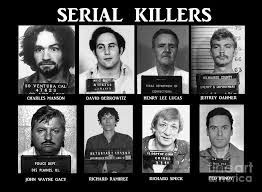
In their study, Sexual Homicide: Patterns and Motives, written by FBI Special Agents Robert Ressler, John E. Douglas, and Dr. Ann W. Burgess, Professor of Psychiatric Mental Health, they give the rationale for their work. “In the 1960s and 1970s, FBI researchers noticed a rise in serial killer cases across the nation. During the 1970s, Special Agents of the FBI’s Behavioral Science Unit (BSK) began profiling serial killers on an informal basis by studying crime scene information to deduce certain offender characteristics and behaviors.” After the informal criminal profiling program began to show promise, the study was formalized during the Reagan administration in 1982 with a grant from the National Institute of Justice.
This initial FBI study was the first to examine sexual murderers collectively as a sub-population. The data was collected from 1979 through 1983 on thirty-six offenders responsible for a minimum of one-hundred and eighteen victims, mostly women. All of the interviews were conducted within the Michigan Department of Corrections prison system, from willing participants of the project.
 The first data for the Violent Criminal Apprehension Program (VICAP) crime report was entered into the FBI’s mainframe computer at the FBI Building in Washington D.C. on May 29, 1985. It marked the pioneering use of artificial intelligence technology in crime scene analysis and criminal personality profiling. Today, the VICAP database is massive and linked to other crime fighting organizations throughout North America and databases worldwide.
The first data for the Violent Criminal Apprehension Program (VICAP) crime report was entered into the FBI’s mainframe computer at the FBI Building in Washington D.C. on May 29, 1985. It marked the pioneering use of artificial intelligence technology in crime scene analysis and criminal personality profiling. Today, the VICAP database is massive and linked to other crime fighting organizations throughout North America and databases worldwide.The criminal profiling project paid particular attention to physical evidence found at crime scenes that may reveal behavioral traits of serial murderers and profile characteristics that are variables which identify the offenders as individuals. Together, they help to form a composite picture of a suspect. Over the life of the study--1976-1986--homicide data was placed in the database in one of five categories: felony murders, suspected felony murders, argument-motivated murders, other identifiable motive (circumstance) murders, and unknown motives for murders.
What investigators discovered was that for every category of murder except unknown motives, there was no more than a 1.5 % increase within that ten year period. Unknown motives--that comprise both serial murders and sexual murders--had a disturbing 14 % increase over the same decade. That is a tenfold increase over the other categories of murders.
According to the late FBI profiler, Robert Ressler, “Apprehension of the sexual murderer is one of law enforcement’s most difficult challenges…. Sexual homicide particularly causes a heightened fear for the community because of its apparent random and motiveless nature. This places public pressure on law enforcement officials to make an arrest in these cases as early as possible.”
Published on January 30, 2015 06:58
January 23, 2015
Chameleon Charm and Serial Killers

In the late nineteenth century, Italian psychiatrist Cesare Lombroso was credited with the theory that some types of people are closer to our primitive ancestors than others. Dr. Lombroso utilized the work of anthropologist Pierre-Paul Broca which relied on facial measurements and anomalies of the skull, face, and body to determine who was--or was not--a criminal type.
 Lombroso based his theory of the born criminal--who was a throwback to earlier hedonistic races--on hundreds of post-mortem examinations of criminals. He compiled a list of criminal traits which included receding hairline, forehead wrinkles, bumpy face, broad noses, fleshy lips, sloping shoulders, long arms, and pointed fingers. This condition was named atavism and was strongly associated with Charles Darwin's Origin of the Species--published in 1859. The belief that there was a face of evil was an easy one for society to accept in the Gilded Age of Queen Victoria.
Lombroso based his theory of the born criminal--who was a throwback to earlier hedonistic races--on hundreds of post-mortem examinations of criminals. He compiled a list of criminal traits which included receding hairline, forehead wrinkles, bumpy face, broad noses, fleshy lips, sloping shoulders, long arms, and pointed fingers. This condition was named atavism and was strongly associated with Charles Darwin's Origin of the Species--published in 1859. The belief that there was a face of evil was an easy one for society to accept in the Gilded Age of Queen Victoria.In the twentieth century, this theory was strongly reinforced in the popular culture through cinema, novels, radio mystery shows, and television crime dramas. Of course, some common criminals undoubtedly conform to the stereotype of the dumb hoodlum by virtue of their less than average intelligence and their need to follow a charismatic leader, popularly known as the Boss or the brains of the outfit. This folklore gives rise to the idea that criminals--psychopaths among them--are easily identified because they look different from normal people.

Rather than scientific, these ideas broke along racial and ethnic lines, and in nineteenth century America, religion was also a prejudicial factor in determining guilt. It was believed that Catholics and Jews bore a greater responsibility for crime, in cities like Boston and New York, than the hard working Protestant folk. The Nazis made great use of this type of junk science against European Jews, which they proudly documented for the world to see in the last century.
Serial killers are cut from different cloth than common criminals. Psychologists have done extensive studies on this unique category of murderer. Their studies have discovered that they tend to be above average in intelligence and some are gifted. These are people who often have a belief that their intellect exempts them from the rules and regulations that were devised to keep other less intelligent people in line, an attitude of entitlement. Their intelligence allows serial killers to tidy up evidence, dispose of the body, and return to their normal façade of life until the urge falls upon them to strike again.
Understanding the construction of the mind simply by looking at physical traits doesn’t work. Serial killers often look normal and blend into the background, so their behavior often requires sophisticated psychological profiling before they are caught. Regrettably, profiling only becomes more accurate as the body count rises, sometimes not even then.
Everything about psychopathic serial killers is frightening. But the most terrifying thing of all is that they look just like the rest of us. These people are often superficially described as charming or engaging--though there are exceptions to be sure.
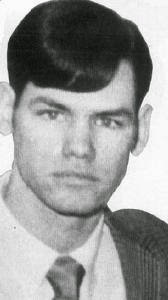 John Norman CollinsEven after the outrages of serial killers have been discovered, many people are dumbstruck despite the evidence that a normal looking person could be responsible for such carnage. It is part of the Dr. Jekyll and Mr. Hyde quality of their personality disorder that enables them to deceive people so easily. They are natural actors because deception and manipulation are second nature to them.
John Norman CollinsEven after the outrages of serial killers have been discovered, many people are dumbstruck despite the evidence that a normal looking person could be responsible for such carnage. It is part of the Dr. Jekyll and Mr. Hyde quality of their personality disorder that enables them to deceive people so easily. They are natural actors because deception and manipulation are second nature to them.The true beginnings of modern crime fighting:http://fornology.blogspot.com/2014/05/the-vidocq-society-private-crime.html
Published on January 23, 2015 16:55
January 20, 2015
John Norman Collins--the Wayside Theater--and The Boston Strangler Movie
 John Norman Collins in 1969 and 2014As I edit The Rainy Day Murders manuscript, material which is either too broad or doesn't advance the story of the Washtenaw County, Michigan murders is being removed. Rather than reject these portions out of hand, I have decided to rework and repurpose some of them in my blog.
John Norman Collins in 1969 and 2014As I edit The Rainy Day Murders manuscript, material which is either too broad or doesn't advance the story of the Washtenaw County, Michigan murders is being removed. Rather than reject these portions out of hand, I have decided to rework and repurpose some of them in my blog.Early on in my research, I interviewed someone who rode motorcycles with accused serial killer John Norman Collins. He asked that I refer to him by his biking nickname. Dundee said that he and several others rode with Collins--who always took the lead position--and toured the back country north of Ypsilanti. This was the area where six of seven bodies of young women were deposited over a two year period. "Collins knew the area like the back of his hand," Dundee said.
I asked him if he had ever seen Collins pick up young women while cruising with him. "Yes, Collins liked riding with girls."
"What was his come-on to these girls?
"When he spotted someone who caught his eye, he'd drive up next to her and gun the bike's engine a few times to get her attention. Then he would grin and ask if she wanted a ride. He was a handsome, clean-cut guy who worked out with weights. Sometimes a girl would hop on the back of his bike, and he'd gun his engine and speed off--usually splitting from the pack. Sometimes John would only make a date or get a phone number.
"How often would this happen?'
"Occasionally. John was popular with the ladies," Dundee grinned.
"Did any of these ladies turn up dead?"
His grin disappeared, "Not that I know of."
"Do you think Collins was guilty of killing any of these girls?
Dundee's answer disappointed me.
"No. I don't believe he killed any of them."
"Not even Karen Sue Beineman, the coed Collins was found guilty of murdering?"
"No."
When I asked why not, he had nothing of substance to say other than John was a scapegoat for the county sheriff. It was obvious that--even after forty-five years--Dundee felt uncomfortable with the subject matter. I was hoping for more incriminating information about Collins. I asked if he had anything else he could tell me about his friend. Then, he shared this anecdote with me.
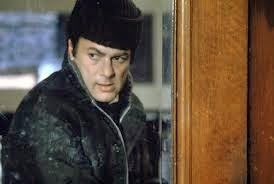 Tony Curtis as The Boston StranglerIn October of 1968, he and Collins went to the Wayside Theater located on Washtenaw Boulevard--between Ypsilanti and Ann Arbor--to see Tony Curtis in The Boston Strangler. The movie had just been released and being shown in the new state-of-the-art theater which could seat one thousand patrons. The Wayside had the biggest screen in the county at that time--56' wide by 24' tall.
Tony Curtis as The Boston StranglerIn October of 1968, he and Collins went to the Wayside Theater located on Washtenaw Boulevard--between Ypsilanti and Ann Arbor--to see Tony Curtis in The Boston Strangler. The movie had just been released and being shown in the new state-of-the-art theater which could seat one thousand patrons. The Wayside had the biggest screen in the county at that time--56' wide by 24' tall.Dundee told me that when the movie was over, John was clearly excited and talkative. "John loved the cool split screen effects where you saw the killer’s view and the victim’s view. We went into the lobby afterwards," Dundee said. "We talked about going someplace to eat when John asked if I would stay and watch the movie again with him.
"I told Collins that Tony Curtis’ performance freaked me out because I liked seeing Curtis in comedies. The role of Albert DeSalvo was too dark and disturbing for me." Dundee took off and left Collins to view the movie a second time alone. What Collins did after the film is anybody’s guess.
Dundee remembered Collins remarking with pride how he thought he resembled Tony Curtis in that role--his looks and mannerisms. “If you watch The Boston Strangler," he said, "the movie very clearly leaves room for a split personality interpretation. Also, Albert DeSalvo--accused serial killer--was never taken to trial or convicted of any of the crimes for which he was accused. The movie’s theme was that he got away with all those murders.”
It should be noted for the record that Albert DeSalvo was recently found to be the Strangler when DNA evidence--recovered in 2013 from his exhumed body--proved he killed Mary Sullivan in 1964.
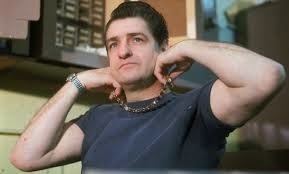 Albert DeSalvo in mental institution with handmade choker chain.It seems clear that John Norman Collins found inspiration and a kindred spirit in Albert DeSalvo--the Boston Strangler--but not motivation--he had plenty of that already. By the time The Boston Strangler movie was released, two of the Washtenaw County murders had already been committed. Regardless, the movie undeniably resonated with Collins.
Albert DeSalvo in mental institution with handmade choker chain.It seems clear that John Norman Collins found inspiration and a kindred spirit in Albert DeSalvo--the Boston Strangler--but not motivation--he had plenty of that already. By the time The Boston Strangler movie was released, two of the Washtenaw County murders had already been committed. Regardless, the movie undeniably resonated with Collins.
Published on January 20, 2015 15:45
January 8, 2015
The Detroit Area Salt Mine
 Bulk salt waiting to be loaded for shipment
Bulk salt waiting to be loaded for shipmentTwelve hundred feet below the surface of the state of Michigan lies the largest salt deposit in the world--over seventy-one trillion cubic tons of salt deposits. Over four hundred million years ago, horizontal salt beds formed as the result of ancient oceans evaporating in what geologists have named The Michigan Basin--a circular pattern of sedimentary strata that began to sink over time.
 This depression of Precambrian (46 billion years ago - 541 million years ago) rock is 16,000' deep at its center and tapers to 4,000' at its edges. The basin extends throughout most of Lower Michigan. As the basin sunk lower into the earth over billions of years, salt water repeatedly back-filled the depression and evaporated leaving the salt behind.
This depression of Precambrian (46 billion years ago - 541 million years ago) rock is 16,000' deep at its center and tapers to 4,000' at its edges. The basin extends throughout most of Lower Michigan. As the basin sunk lower into the earth over billions of years, salt water repeatedly back-filled the depression and evaporated leaving the salt behind.This occurred during the Cambrian Period (542 million years ago - 488 million years ago) of the earth's development before the age of the dinosaurs. The only life on the planet were hard-shelled aquatic trilobites. These ancient salt beds were buried by the Niagara Escarpment--a thick layer of basalt rock formed by the rapid cooling of volcanic lava--and glacial activity from four ice ages.
***
Rock salt was discovered beneath Detroit in 1895. Eleven years later, work began on the first tunnel shaft--which was was completed in 1910--at the cost of many lives and the bankruptcy of the mine's original owners. In the early days of mine operation, mules were lowered in harnesses into the mine to live out their lives as beasts of burden. By 1914--due to the use of electric energy and advancements in mining technology--the mine was producing 8,000 tons of salt a month for the leather and food processing industries.

In 1922, a second, larger mine shaft was begun and finished in three years. The first shaft was now used to haul men and small materials. The new shaft was used to lower machinery used in the mine. Most equipment was massive and had to be disassembled on the surface--piece by piece--and reassembled in the machine shop below.
The mine has changed hands many times in its over 100 years of existence. International Salt closed the mine in 1983 because of falling prices, but its present operator--Detroit Salt Company--reopened the mine in 1998. Today, the only products the Detroit mine produces are deicing rock salt for roadways and bagged rock salt for consumer use. From the 1920s until the 1980s, guided public tours were allowed by the mine's management. Since the new owners took over, only rare private tours are given.
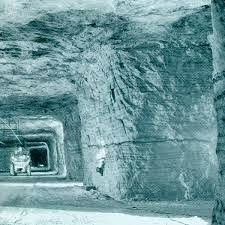 Salt PillarThe room and pillar method of extraction is used to mine salt. The rooms vary in width from 30' to 60'--with a height of between 17' to 40'. For safety reasons, a minimum of 30% of any cavity must be pillared. During the day and afternoon shifts, miners undercut a solid wall surface at floor level with an industrial-sized chain saw device that bites out a channel ten or more feet deep. This first cut leaves a smooth floor for picking up the salt after blasting. Deep holes are drilled at strategic places along the face of the wall and loaded with explosives that are set off electronically after the work shift.
Salt PillarThe room and pillar method of extraction is used to mine salt. The rooms vary in width from 30' to 60'--with a height of between 17' to 40'. For safety reasons, a minimum of 30% of any cavity must be pillared. During the day and afternoon shifts, miners undercut a solid wall surface at floor level with an industrial-sized chain saw device that bites out a channel ten or more feet deep. This first cut leaves a smooth floor for picking up the salt after blasting. Deep holes are drilled at strategic places along the face of the wall and loaded with explosives that are set off electronically after the work shift.The next morning, heavy equipment loads the large salt pieces and takes them to massive crushers where they are loaded onto conveyor belts and hauled to the surface in buckets capable of lifting 100 tons. Once above ground, the salt is screened and sorted for size. Some of the salt is conveyed to individual storage bins to await packaging. The rest is loaded into railroad cars, semi-trucks, or river barges and sold as bulk salt.

Here are some factoids about the Detroit salt mine:
the tunnel's shafts are deeper than the height of the Empire State Buildingthe mine's temperature is a constant 56-60 degreesthe mine covers an area of over 1,500 acresthe mine head is in Southwest Detroit and the mine extends beneath the eastern portions of Dearborn, much of Melvindale, and the northern reaches of Allen Park there are one hundred miles of roads cut through the salt beds the underground streets are 60' wide to handle the heavy loading equipment100,000 cubic feet of fresh air is pumped into the mine per minuteno living thing exists in the mine except the minersthe mine shaft opening is at 12841 Sanders Street, Detroit, Michigan 48217. In 1940, Detroit was the first major city in America to use rock salt for snow removal. The increased salt level buildup in the soil along Michigan roadsides has caused native roadside vegetation--like cattails--to be replaced with salt water tolerant plants--like sea grass. Over time, seeds from these invasive aquatic plants were inadvertently spread by transport trucks from ocean coastal areas to the Midwest. Now these plants have a foothold in the Michigan soil.
Published on January 08, 2015 07:00



